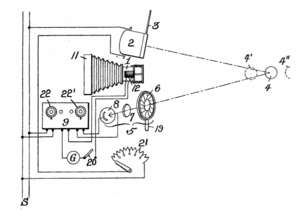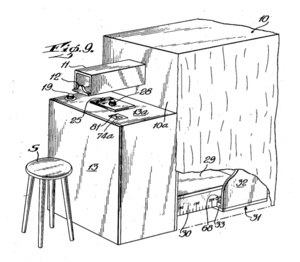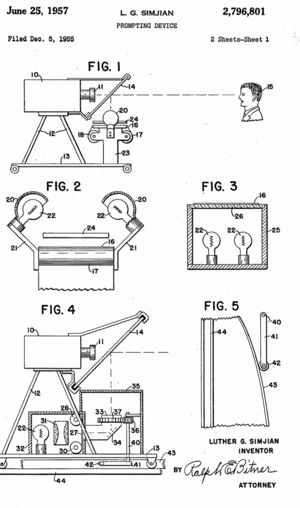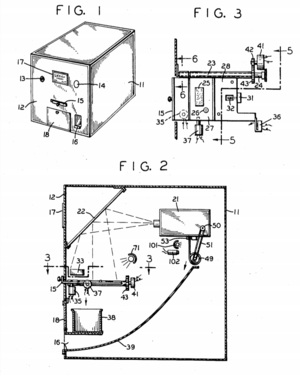Luther Simjian facts for kids
Quick facts for kids
Luther George Simjian
|
|
|---|---|
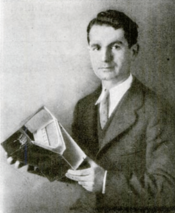
Simjian holding his self-photographing camera in 1929
|
|
| Born | January 28, 1905 Aintab, Ottoman Empire (now Gaziantep, Turkey)
|
| Died | October 23, 1997 (aged 92) Fort Lauderdale, Florida, U.S.
|
| Nationality | Armenian |
| Citizenship | United States |
| Occupation |
|
Luther George Simjian (born January 28, 1905 – died October 23, 1997) was a super creative inventor and businessman from Armenia and America. He invented over 200 things, mostly dealing with cameras, lights, and electronics! Some of his most famous inventions include an early flight simulator, what many call the first ATM, and improvements to the teleprompter.
Contents
Early Life and Moving to America
Luther Simjian was born in a place called Aintab in the Ottoman Empire (which is now Gaziantep, Turkey) on January 28, 1905. When he was young, his family had to leave their home and move to Syria. Later, he traveled to France and then to the United States by the end of 1920.
He first lived in New Haven, Connecticut, with his uncle. He found a job coloring photographs. He also finished school at Booth Preparatory School in New Haven.
Starting Out at Yale and First Inventions
Simjian began working at the Yale School of Medicine in their photography lab. He was interested in becoming a doctor at first, but he soon decided that photography was his real passion. As a medical photographer, he took pictures of medical samples and made slides for doctors to use in their classes.
In 1928, Simjian started and became the first head of the photography department at the Yale School of Medicine. He worked there until 1934. After leaving Yale, he moved to New York City. There, he took classes to learn more about business, writing, and banking. He wanted these skills to help him promote his inventions.
The Self-Photographing Camera
Simjian loved portrait photography. He wasn't happy with how yearbook photos were always the same. This led him to invent a camera that could take pictures of itself, called the PhotoReflex. In 1929, he applied for a patent for his "Pose-reflecting system for photographic apparatus."
This invention was featured in Popular Science magazine. It allowed the person getting their picture taken to look into a mirror and see exactly how they would look in the photo. To make this new camera, Simjian worked with a company called Sperry Corporation. They set up a company named PhotoReflex, just like the camera.
In 1931, the camera was introduced at the Wanamaker's department store in New York City. It was inside a portrait cabinet. People could see themselves in the mirror and get their picture taken right away. The invention was talked about a lot in the news back then.
The Self-Focusing Camera
The self-photographing camera also led Simjian to invent the autofocus (self-focusing) camera. He applied for a patent in June 1931 and received it in July 1932. This invention "changed the whole photography industry." Even though he didn't make a lot of money from his autofocus invention, it brought him a lot of attention. He later sold the rights to the PhotoReflex camera and name. However, he kept the rights to use the technology for other things besides photography.
Color X-ray Machine
In June 1934, Simjian was granted a patent for a color X-ray machine. He had thought of the idea at Yale while trying to make better lecture slides. He decided to use new television technology for X-ray images. His machine could scan in three different colors. Each color could be made clearer if needed. Then, the three scans could be put back together to create a colored image. These separate scans could also be sent through a wire to another place for doctors to look at. This invention changed the field of X-ray technology. Time Magazine and The Literary Digest reported on this in July 1934.
After this, Simjian traveled to Europe and set up a lab in London. He also started a company called Miroflex to make the PhotoReflex camera. But his plans were changed when World War II started. Production then focused on military needs instead of commercial ones.
Reflectone and the Flight Simulator
In 1939, Simjian started Reflectone Corporation in Stamford, Connecticut. This company was created to develop and make his inventions. He was the president and chairman of Reflectone until he sold it in 1961. Under his leadership, the company became very successful.
One of his first inventions at Reflectone was a spinning chair with a movable mirror. It was designed for women to use when putting on cosmetics. A person could sit in front of a mirror, spin around, and still see the back of their head. This left both hands free. The chair was called the Reflectone Mirror Chair and sold pretty well. During his time at Reflectone, Simjian also invented a way to develop a photo instantly while still keeping the negative.
During World War II, Simjian invented a special training machine for pilots. It was the "first flight simulator of its kind." He filed for a patent in February 1943 and received it in January 1946. This machine helped pilots learn to identify aircraft or ships. It also helped them figure out how fast and in what direction planes were moving. These skills were very important for combat flying.
He designed this 3D device using mirrors, similar to his PhotoReflex camera and mirror chair. It also used an airplane model and controlled lighting. An instructor could change the speed and angles of the model plane from far away. The student pilot or gunner would watch through a special sight. This made it feel like they were flying, helping them learn to spot enemy planes and judge their movement.
During the war, Reflectone sold over 2,000 of these devices to the U.S. military. The company grew very fast to make all these trainers. The number of employees went from three to over 100, and then to 250 by 1950. The War Department said the device helped the air war be successful. Simjian believed it was his "most significant invention" from that time because it saved so many lives. He even received an award from Admiral William Halsey Jr. who said his device saved thousands of American servicemen's lives.
Later Inventions and the ATM
After Reflectone, Simjian started two more companies: General Research Inc. and Command Automation Inc. The second one was a research lab in Fort Lauderdale, Florida. His later inventions were very different and unique. He once said, "One thing I discovered about myself in the early days of my life is that I can't stick with just one idea for too long." Between 1956 and 1963, he received about 75 patents, which was his busiest time for inventing.
The Teleprompter
Simjian held a patent for the teleprompter. However, he wasn't the only one who invented it. The invention is often credited to Hubert Schlafly and Fred Barton, who created a mechanical cueing device in the 1950s. Simjian and Jess Oppenheimer, who created the famous TV show I Love Lucy, improved it. They replaced the mechanical version with an optical teleprompter.
The optical teleprompter allowed a speaker to look directly at the camera while reading their lines. This made it seem like they were making eye contact with the audience. Simjian applied for a patent for this "prompting device" in 1955, and it was granted in 1957.
The Bankograph (Early ATM)
Simjian invented something that many people say was an early version of the automated teller machine (ATM). Because of this, Simjian is often called the inventor of the ATM or the person who first thought of the idea. Many experts believe that the first automatic banking machine was his creation. He came up with the idea of a "hole-in-the-wall machine" that would let customers do banking transactions.
Simjian received over 20 patents for his Bankograph. His "Apparatus for collecting an article for deposit" (filed in 1958) was granted in March 1960. The New York Times wrote about it, calling it a "robot bank teller that gives the depositor a picture of the money he puts in." This meant there could never be any doubt about how much money was deposited. In 1960, Simjian also filed for a patent for a device that included an ATM taking a picture of the deposited check.
The Bankograph was an automatic deposit machine that accepted cash and check deposits at any time. A camera inside the machine took pictures of the deposits. Customers received copies of these pictures as receipts. Simjian showed it to the public in 1961. It was placed in a few City Bank of New York lobbies for six months. However, the bank stopped using it because not many people wanted to use it. Some say it failed because it was too different from how people usually did banking back then. The New York Times wrote in 1998 that it was his most famous invention, and "the basis for the now-ubiquitous A.T.M., from which he never made a penny."
Even though it wasn't a big success at first, a 2009 study said that Simjian was the first to think of the ATM concept (1957), get the first patent (1957), and create the first prototype (1960).
Other Inventions
Simjian's other inventions were quite varied! They included an indoor computerized golf practice range (in the 1960s), an exercise bicycle that massaged the rider (1973), and a golf training aid to help with putting (1981). He also invented a way to remotely access an automatic postage meter (1981), which was bought by Pitney Bowes. Other ideas included a method for making meat more tender, golf balls, cooking devices, using ultrasound to prevent fake money, an athletic shoe, and a bandage. He even went back and improved some of his earlier inventions. His eyesight got much worse in his later years, but he kept inventing. His last patent was granted just a few months before he passed away in March 1997.
Personal Life
Simjian could speak Arabic, French, and English, though he had a strong accent. He enjoyed playing golf and backgammon. He also liked the books of Mark Twain, collecting porcelains, and Middle Eastern food.
Simjian became a U.S. citizen in 1929, nine years after he arrived in the country.
He married Gladys Cannon in April 1936. They had met at a party in New York's Greenwich Village in 1935. They had two children: Maryjo Garre and Ronald Simjian.
Luther Simjian passed away at the age of 92 on October 23, 1997, at his apartment in Fort Lauderdale, Florida.
Legacy and Recognition
The American National Biography describes Luther Simjian as a "pioneer in photographic and optical inventions."
Simjian didn't like being in the spotlight and was a very private person. Few people knew his name, as Ardy Friedberg wrote in the Sun-Sentinel in 1997. Simjian wrote his own book, Portions of an Autobiography, in 1997, just before he died. During his seven decades as a professional inventor, Simjian received over 200 patents from America and other countries. After he died, people compared him to famous inventors like Thomas Edison. The Times Union wrote that Simjian was like "Jeffersonian, Edisonian, da Vincian — take your pick. His motley inventions enriched life and gave jobs to untold thousands."
Friedberg called his life a true "American success story." His patent agent, Ervin Steinberg, said Simjian was "one of the most prolific inventors of [the 20th] century."
Awards and Honors
- He received the Award of Appreciation from the State of Florida in 1961.
- In June 1963, Science Digest magazine named Simjian "Inventor of the Month."
- In 1978, Simjian received the Eli Whitney Award for his important contributions to law or science.
- In 2019, Simjian was honored by being inducted into the Florida Inventors Hall of Fame. His many inventions have helped advance technology, including in Florida's theme parks.


